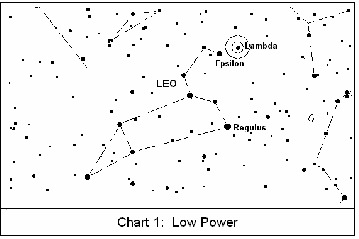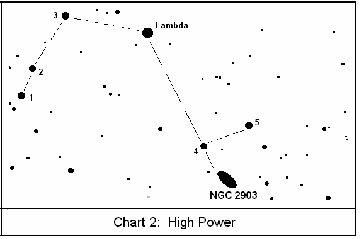 |
|
||||||||||||||
![]()
Can You
Spot This?
There are five Messier galaxies in the constellation Leo. All have about the same brightness, magnitude 9. There is another galaxy in Leo that I find more interesting—NGC 2903. It is also magnitude 9. But this spiral galaxy is larger than the other five. And probably easier to locate.
Start by finding the famous sickle asterism in Leo that begins with Regulus and ends with Epsilon. See Chart 1 for reference. Epsilon is a magnitude 3 star. To its right is our target star, Lambda. At magnitude 4, it is easy to see with the naked eye.
With a low-power eyepiece in your telescope, aim your Telrad or other finder at Lambda. Once it is centered, change to a high-power eyepiece. Look for the pattern of stars shown in Chart 2. If you are unable to see this pattern, you might want to switch back to lower power.
Notice the two patterns of sixth and seventh magnitude stars: 1, 2, 3, 4, and 5. Starhop from Lambda to star 4 to NGC 2903. You should be able to make that starhop in one easy sweep. Increase your power to view more of this spiral galaxy. Remember the star patterns shown are for a reflector. You may have a reverse image for other types of scopes.
NGC 2903 has a very large and bright central core that accounts for about half of its total visible area. Because it is so bright and easy to locate, it is usually included in most observers’ “top ten objects that they wonder why Messier failed to include in his famous list” lists.
OBJECT STATISTICS:
Name: NGC 2903
Type: Spiral Galaxy
Magnitude: 9.0
Size: 12.0' x 5.6'
Coordinates: 9 hr. 32 min. 12 sec.; +21 deg. 30 min.
![]()
![]()
![]()
Can You Spot
This?
NGC 2903
by John Barra
![]()


![]()
copyright © Peoria Astronomical Society 1994-2004.